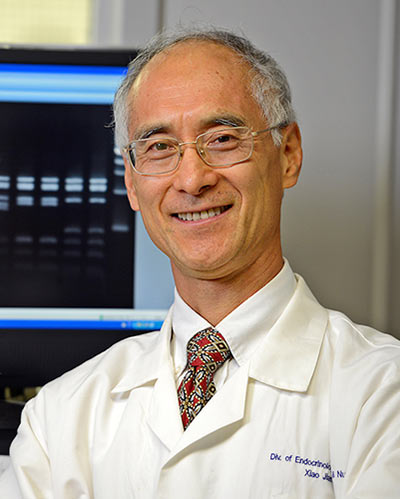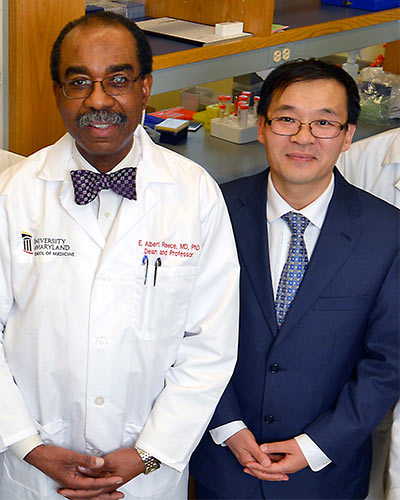September 12, 2017 | David Kohn

Study Uncovers a Previously Unknown Connection, Which Is Crucial To Disease Progression
A new study by researchers at the University of Maryland School of Medicine (UM SOM) has uncovered an explanation for how inflammation contributes to a key feature of diabetes, the body’s inability to metabolize glucose, a condition known as insulin resistance.
More than 30 million Americans suffer from diabetes. It is the 7th leading cause of death in the United States. Nearly 80,000 people died directly from the disease, while for another quarter million, it was an underlying or contributing cause of death. The total cost of the disease in the US comes to nearly $250 billion. Nearly all of these cases are type 2 diabetes, which appears in adulthood. Type 1 appears in childhood, and is caused by the body’s immune system attacking the cells that make insulin.
Surprisingly, the underlying molecular mechanism for insulin resistance and type 2 diabetes remains mysterious. Diabetes occurs when the body cannot metabolize glucose properly. Normally, the hormone insulin breaks down glucose. But in some people this process becomes increasingly inefficient, a phenomenon known as insulin resistance. Until now, researchers had not understood how insulin resistance turns into full-blown diabetes, in which the body is unable to metabolize sugar properly.
The findings were published recently in the journal Journal of Biological Chemistry. The study is the first to identify a new molecular link between inflammation and the disease.
“Until now, we didn’t really understand how insulin resistance occurred,” said Xiao-Jian Sun, PhD, an assistant professor in the Department of Medicine at UM SOM. “Our study has done something new: it has identified a new molecule involved in the development of insulin resistance.”
Dr. Sun’s previous research began by focusing on two molecules, Insulin Receptor Substrate-1 and Insulin Receptor Substrate-2, known as IRS-1 and IRS-2. They are key signaling molecules that allow insulin to do its work. In the body, insulin has many jobs: it synthesizes fat, it promotes muscle growth and it breaks down glucose. This is why, in diabetes, patients have multiple problems: the hormone plays many roles.
Over the years, researchers have noticed that many patients suffer from both type 2 diabetes and chronic inflammation. Chronic inflammation is caused by many factors, including aging, obesity, and high sugar consumption. These factors also increase the risk of diabetes.
It appears that a gene called IRAK1 (Interleukin-1 receptor-associated kinase 1) plays a key role in this process. For years, researchers have known that inflammation activates IRAK1. Dr. Sun’ team discovered that this enzyme blocks insulin signaling in muscle by blocking IRS-1. This blocks insulin signaling, and as a result, significantly reduces the ability of insulin to metabolize glucose in muscle.
His team then tested mice that had been genetically modified so that they lacked IRAK1. They found that these mice had significantly higher insulin sensitivity in muscle than that of regular mice. “What we suspect is that high IRAK1 activity is bad in humans,” Dr. Sun says. “It increases insulin resistance, particularly in muscle. This gives us insight into how to improve insulin resistance in patients with diabetes.”
Dr. Sun says that in the future it may be possible to test diabetes patients to see what version of IRAK1 they have. Some people have a more active version of the gene, while others have a less active version. With this test, it may be possible to predict how much insulin resistance might be possible with weight loss or other preventive measures. In addition, in the future he hopes to look for drugs that can inhibit IRAK1 activity.
“Diabetes remains one of our country’s most urgent public health challenges,” said UM SOM Dean E. Albert Reece, MD, PhD, MBA, who is also the vice president for Medical Affairs, University of Maryland, and the John Z. and Akiko K. Bowers Distinguished Professor. “Especially because it a chronic illness, it causes enormous suffering not only for patients but for their families patients. Dr. Sun’s new paper opens up a new avenue that has the potential to eventually help millions of patients with the disease.”
About the University of Maryland School of Medicine
Commemorating its 210th Anniversary, the University of Maryland School of Medicine was chartered in 1807 as the first public medical school in the United States. It continues today as one of the fastest growing, top-tier biomedical research enterprises in the world -- with 43 academic departments, centers, institutes, and programs; and a faculty of more than 3,000 physicians, scientists, and allied health professionals, including members of the National Academies of Science, Engineering and Medicine, and a distinguished recipient of the Albert E. Lasker Award in Medical Research. With an operating budget of more than $1 billion, the School of Medicine works closely in partnership with the University of Maryland Medical Center and Medical System to provide research-intensive, academic and clinically-based care for more than 1.2 million patients each year. The School has over 2,500 students, residents, and fellows, and nearly $450 million in extramural funding, with more than half of its academic departments ranked in the top 20 among all public medical schools in the nation in research funding. As one of the seven professional schools that make up the University of Maryland, Baltimore campus, the School of Medicine has nearly 7,000 total employees. The combined School and Medical System (“University of Maryland Medicine”) has a total budget of $5 billion and an economic impact of nearly $15 billion on the state and local community. The School of Medicine faculty, which ranks as the 8th-highest public medical school in research productivity, is an innovator in translational medicine with 600 active patents and 24 start-up companies. The School works locally, nationally, and globally, with research and treatment facilities in 36 countries around the world. Visit medschool.umaryland.edu/
Contact
Office of Public Affairs
655 West Baltimore Street
Bressler Research Building 14-002
Baltimore, Maryland 21201-1559
Contact Media Relations
(410) 706-5260
Related stories

Friday, March 08, 2024
People with Diabetes Who Live in Rural Areas More Likely to Develop Complications of the Disease, UM School of Medicine Study Finds
It has been well established that people who live in rural areas in the U.S. are more likely to have diabetes and experience barriers to managing their condition compared to those who live in the suburbs and cities. Now University of Maryland School of Medicine researchers have measured the devastating toll of this health disparity.

Monday, December 10, 2018
As Health Threats of the Diabetes-Obesity Epidemic Increase, Two Leading OB-GYN and Maternal-Fetal Medicine Experts Publish New Book on Diabetes and Obesity in Women
With diabetes and obesity continuing to escalate at alarming rates in the U.S., particularly among women, a new book has been published that provides the most comprehensive, expert coverage of this urgent topic to date.

Friday, May 12, 2017
University of Maryland School of Medicine Researchers Identify Gene That Controls Birth Defect Common in Diabetes
Researchers at the University of Maryland School of Medicine (UM SOM) have identified a gene that triggers a process leading to the formation of neural tube defects, a problem commonly found in infants of pregnant women with diabetes. This is the first time the gene has been shown to play this role; it opens up a new way to understand these defects, and may one day lead to new treatments that could prevent the problem or decrease its incidence.
